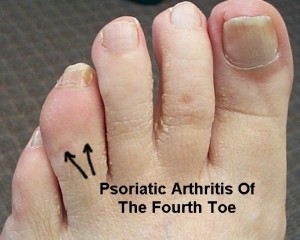Psoriatic Arthritis
Psoriasis is a scaly rash that occurs most frequently on the elbows, knees and scalp, but can cover much of the body. It is a chronic, inflammatory disease of the skin, scalp, nails an
d joints. A normal skin cell matures and falls off the body’s surface in 28 to 30 days, but a psoriatic skin cell takes only three to four days to mature and gathers at the surface, thus forming lesions.
Up to 30% of people with psoriasis also develop psoriatic arthritis. In most cases the psoriasis will precede the arthritis, sometimes by many years. When arthritis symptoms occur with psoriasis, it is called psoriatic arthritis (PsA). In these cases, the joints at the end of the fingers are most commonly affected causing inflammation and pain, but other joints like the wrists, knees and ankles can also become involved. This is usually accompanied by symptoms of the fingernails and toes, ranging from small pits in the nails to nearly complete destruction and crumbling as seen in reactive arthritis or fungal infections.
About 20% of people who develop PsA will eventually have spinal involvement, which is called psoriatic spondylitis. The inflammation in the spine can lead to complete fusion – as in ankylosing spondylitis – or skip areas where, for example, only the lower back and neck are involved. Those with spinal involvement are most likely to test positive for the HLA-B27 genetic marker.
The least common type of psoriatic arthritis is also the most severe. Called ‘psoriatic arthritis mutilans’, it occurs in about 5% with psoriatic arthritis. Arthritis mutilans is the most severe form of arthritis associated with psoriasis. This form of the disease results in widespread destruction of the joints. When this affects the hands, it can cause a phenomenon sometimes referred to as ‘telescoping fingers.’ Similar changes can occur in the feet.
Is There a Cure?
Although there is currently no known cure, there are treatments and medications available to reduce symptoms and manage the pain and inflammation caused by PsA.
Causes of Psoriatic Arthritis
Arthritis
The exact cause of psoriatic arthritis is not known, but it is known that heredity plays a large role. Up to 40% of people with PsA have a close relative with the disease, and if an identical twin has it, there is a 75% chance that the other twin will have PsA as well.
Disease Course / Prognosis
Disease course and prognosis varies from individual to individual and also depends which form the disease takes (see above). For example, someone who is HLA-B27 positive is more likely to have the disease progress to involve the spine.
Also, the severity of the rash does not mirror the severity of the arthritis, and the skin condition does not necessarily occur at the same time as the arthritis.
